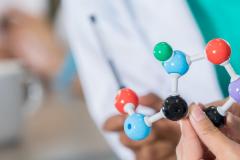
Stem cell-based therapies are some of the most promising approaches for treating type 1 diabetes (T1D), an autoimmune disease that destroys insulin-producing beta cells. Beta cells sense glucose (sugar from foods) and release insulin into the blood to regulate energy delivery to the cells all over the body. Stem cells can be transformed into replacements for these insulin-producing cells, but stem cell-derived cells are “immature” and, as a result, don’t sense glucose levels properly so they don’t release enough insulin. Researchers at BC Children’s Hospital Research Institute (BCCHR) have been investigating the biological pathways underlying maturation and how to make these cells work more effectively. In a paper recently published in Nature Communications, they showed that a protein called MED15 is essential for maturation, which wasn’t previously known.
“This knowledge will help us improve the formation of functional insulin-producing cells from stem cells,” says Dr. Francis Lynn, co-lead in the study, investigator with the Canucks for Kids Fund Childhood Diabetes Laboratories at BCCHR, and associate professor in the Department of Surgery and in the School of Biomedical Engineering at the University of British Columbia (UBC). “MED15 is part of the Mediator Complex, a family of proteins that hasn’t previously been implicated in insulin-producing cells in any context.”

Dr. Lynn co-led this comprehensive study with Dr. Stefan Taubert, investigator at the Centre for Molecular Medicine and Therapeutics at BCCHR and professor in the Department of Medical Genetics at UBC.
When a child has T1D, their body’s immune system mistakenly attacks and kills beta cells. Without these cells and the insulin they produce, blood sugar levels increase, leading to potentially life-threatening complications. The most common T1D treatment involves injecting insulin to regulate blood sugar levels. “Beta cells can continuously measure glucose levels and respond by secreting the appropriate amount of insulin,” Dr. Taubert says. “By comparison, injecting insulin is a crude substitute.”
Scientists are focused on discovering how to generate more functional insulin-producing cells suitable for transplantation — a crucial step forward in their research. That is how they could potentially design therapies that improve the quality of life of children and adolescents living with T1D. “If we can replace those cells, patients will no longer have to think about measuring glucose levels or injecting insulin,” says Dr. Lynn, who also leads a national research team working towards accelerating the development of stem cell-based therapies for T1D at BC Children’s Hospital.
Replacing beta cells is possible. They can be isolated from the organ donor pancreases and transplanted into people with T1D to help them start making insulin.
“As with any transplantation procedure, one of the drawbacks is that there aren’t enough donors, so we're investigating ways to make a limitless supply of beta cells in the lab to care for more patients,” Dr. Taubert says.
For the last 20 years, researchers have been working on ways to make stem cells develop into insulin-producing cells in a laboratory environment, and they’ve achieved good results. The current challenge is to develop methods to ensure the effective and adequate maturation of stem cell-derived beta cells. “The cells we develop in the lab are making insulin, but they’re not sensing glucose appropriately and they’re not releasing enough insulin into the blood to properly control cells all over the body,” says Dr. Taubert.
The findings described in Dr. Lynn and Dr. Taubert’s paper show that MED15 helps coordinate the earliest stages of protein production. It acts as a node where different proteins that regulate the conversion of DNA into RNA, known as transcription factors, interact. This interaction is key to driving the maturation of stem cell-derived beta cells so they can properly sense glucose and secrete insulin.
“With the new information we’ve gained, we know there’s a potential to use pharmaceutical drugs that could manipulate the interactions between MED15 and the transcription factors driving maturation,” Dr. Lynn says.
Currently, there are no clinical trials for children living with T1D due to the potential risks involved in using stem cells as a source for beta cell replacement. Eligibility for those trials is stringent and well controlled to ensure their success, and the required immunosuppression is not safe for kids. Based on clinical trials in adults, we know that the cell source needs to be improved before designing a cell therapy that could be applicable to children.
“Our research is a stepping stone towards improving the cell source that could eventually be transplanted into patients in our hospital,” says Dr. Lynn, highlighting the ongoing research on other potential roles of MED15. “Advancing a cell therapy that can replace the beta cells destroyed in children and adolescents who live with T1D is the whole reason for this work because this advancement will significantly improve their quality of life.”




